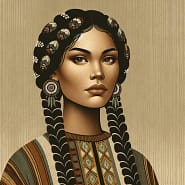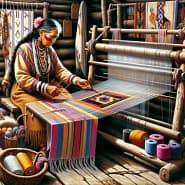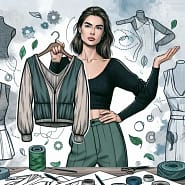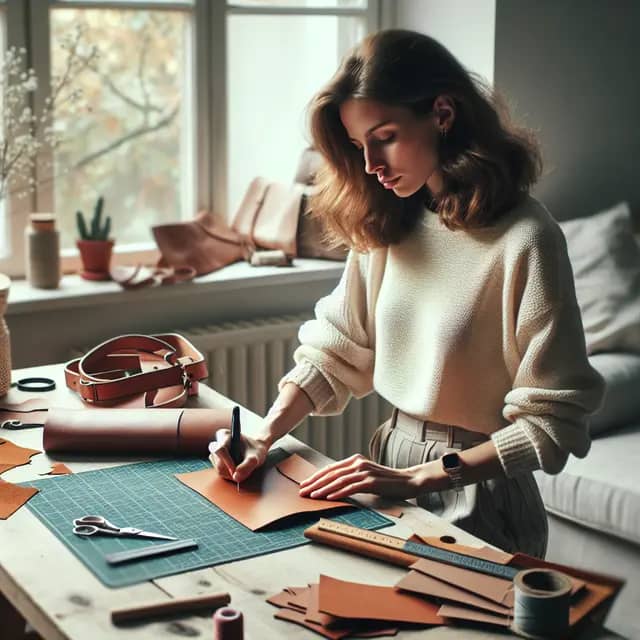Introduction: The versatility of scarves in every season
The classic scarf is not just an accessory, it’s a year-round style staple that brings both function and fashion to any outfit. Whether it’s a lightweight silk one adorning your summer outfit or a cozy knit one providing warmth in the winter, every season brings a new way to showcasing your scarf and enhances the charm of your attire!
In this article titled, “How to Style a Scarf for Every Season,” we will explore different styles, materials, and ideas on how to style a scarf for every season. Here’s a quick rundown on what we’ll discuss:
- Summer: Lightweight scarves and creative ways to wear them
- Fall: Transitioning to cozy knit scarves and layering techniques
- Winter: Styling scarves for ultimate warmth and comfort
- Spring: Incorporating scarves into your transitional wardrobe
- Different scarf materials for different seasons
- Mixing and matching colors and patterns for all seasons
- Ways to tie a scarf for different looks
- Choosing the right scarf length for your outfit
- Tips for caring for your scarves to make them last longer
Whether you’re new to the world of scarves or an experienced scarf enthusiast, this comprehensive guide will provide a wealth of inspiration and practical tips for enhancing your style with scarves all year round. So, let’s dive into the world of scarves and unlock new facets of your wardrobe!

1. Summer: Lightweight Scarves and Creative Ways to Wear Them
When the temperature rises, the thought of adding a scarf to your outfit may seem unappealing. However, lightweight scarves are a perfect way to spice up your summer ensemble. They not only serve as a fashionable accessory, but can also provide protection from the sun’s harmful UV rays.
Here are some creative ways to tie and style your lightweight summer scarves:
- Tie it around your neck: Opt for a playful, casual knot or a chic loose knot that lets the scarf hang.
- Wear it as a headband: Fold your scarf into a triangle, roll it up, then tie it around your head like a retro turban.
- Use it as a belt: Thread a long, skinny scarf through your belt loops for a unique, hip look.
- Turn it into a top: Get creative and transform your scarf into a top. Twist the scarf into a bralet or simple halter neck top, perfect for hot summer festivals.
- Wrap it as a shawl: Place the scarf on your shoulders then loosely drape the ends on your arms for an elegant look.
- Attach it to your bag: For an instant spruce up, tie your scarf to the handle of your tote or sling bag.
These are just a few ideas to get you started with your summer scarf styling. Remember, the most important thing is to have fun and express your individuality through your style. As the summer sun blazes, let your creativity run wild with the versatile lightweight scarf!
Be sure to join us next as we transition into fall, introducing cozy knit scarves and layering techniques. You won’t want to miss it!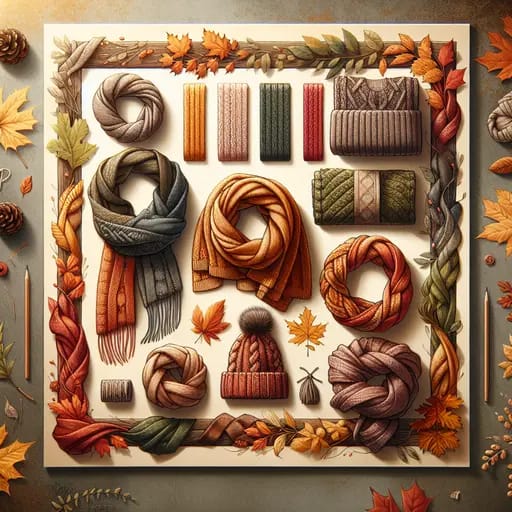
2. Fall: Transitioning to cozy knit scarves and layering techniques
When the leaves begin to turn and that crisp autumn air starts to nip at your nose, it’s a clear signal that Fall has arrived. It’s a perfect time for you to cozy up in a warm knit scarf. Whether you choose chunky, bold scarves or stick with thinner everyday staples, we’ve got you covered with stylish layering techniques perfect for fall.
- Chunky Knits: The epitome of fall scarves is the chunky knit. Not only does it provide warmth, but it also adds a new dimension to a typical fall wardrobe. Chunky scarfs can be paired with light sweaters or jackets to balance out your outfit.
- Warm Tones: Fall is all about warm colors. Think deep mustard, forest green, an array of reds and oranges. A colorful scarf can transform your outfit and blend perfectly with the fall season.
- Layering Techniques: If you find a simple drape too mundane, try out interesting layering techniques. Here are a few you can try:
- The Pretzel: Loop the scarf around your neck once, then take one end over and under the loop.
- The Pull Through: Fold your scarf in half, drape it over your neck, and then pull the loose ends through the loop created by the fold.
- The Infinity : Tie the ends of the scarf together, then loop it twice around your neck, hiding the knot at the back.
Remember that styling your scarf is about personal preference, but these tips should give you a few ideas to try out this fall season. The ultimate goal is to keep you warm and looking stylish. So, dig out your beloved scarves, or add a few new ones to your collection, and celebrate fall in the coziest way possible!
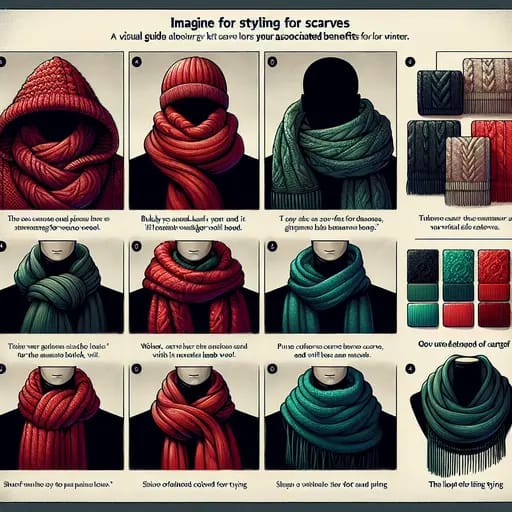
3. Winter: Styling Scarves for Ultimate Warmth and Comfort
As the temperatures plunge, and the chilly winds start whistling, there is no better way to stay toasty and stylish than by adorning a comfortable, warm scarf. Here, we will explore how to style your winter scarves for ultimate warmth and comfort.
- Embrace the bulk: In the heart of winter, nothing feels better than sinking into a fluffy, bulky scarf. Opt for oversized knits, which can act both like a scarf and a hood. These are not only incredibly warm and cozy but also give an avant-garde edge to your ensemble.
- p>Opt for woolen scarves: The interesting and attractive textures of woolen scarves indeed catch the eye. But it is their heat retention properties that make them winter essentials. Choose from merino wool, cashmere or lamb wool for utmost warmth.
- Play with colors: As winter often comes with a palette of blacks and greys, introducing rich hues can add vitality and vibrancy to your winter attire. Try a brilliant red or an emerald green scarf for that much-needed color-pop.
- Master the art of layering: Remember, winter is when your scarf styling needs to be more about functionality than fashion. Hence, mastering the art of layering is crucial. Wrap and drape your scarf such that it covers your neck and reaches the inner layers of your clothing for increased warmth.
Now, let’s have a glance at some timeless scarf-tying techniques that are perfect for winter.
- The loop and pull: This is a classic way to tie your scarf when you are in a rush. Simply fold the scarf in half, hang the folded scarf around your neck, and loop the other end through. This gives you a chic yet snug look.
- The French knot: This sophisticated style of knotting is perfect for long scarves. Fold the scarf in half lengthwise, wrap it around your neck, and tuck both ends into the loop you’ve created.
- The infinity loop: This technique works best with long infinity scarfs. Just wrap the scarf around your neck twice, and voila! You have a cozy, chic, and snug fit.”
Remember to play around with different styles and techniques. The very practicality and versatility of scarves is that their styles can be changed based on moods, outfits, or even the weather! So, brace the cold in style this winter with your fun and warm scarf stylings. Stay tuned for our next section, where we will dive into incorporating scarves into your transitional wardrobe for spring.
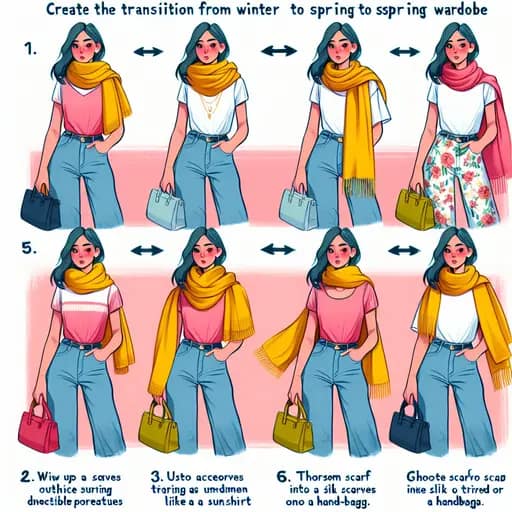
4. Spring: Incorporating Scarves Into Your Transitional Wardrobe
The transition from winter’s cozy knits to summer’s lightweight fabrics presents the perfect opportunity to incorporate scarves into your spring wardrobe. From the bright and bold colors to the lighter fabrics, spring scarves offer the much-needed versatility for this transitional season. Here are a few ways in which you can use scarves to enhance your spring outfits.
- Pair your spring scarves with basic outfits: Whether it’s a classic jeans and t-shirt look or a simple sundress, a vibrantly-colored scarf can add that necessary pop of color and pattern.
- Use scarves as a layering piece: During the unpredictable spring weather, a scarf can act as an excellent layering piece. On a slightly colder spring day, a medium-weight scarf can provide warmth without the bulkiness of a winter scarf.
- Transform your scarf into an accessory: Scarves aren’t just for wearing around your neck. Get creative and use your scarf as a headband or tie it onto your handbag for an effortless style upgrade.
- Choose the right fabric: Cotton, silk or light linen scarves are perfect for spring. They’re breathable, versatile, and perfect for fending off a subtle breeze.
The key to dressing for spring lies in determining the style, fabric, and color of your scarf that best complements your outfit. Remember, the scarf is not just a necessity but also a style statement that enables you to play around with different looks during this transitional season. More so, the right spring scarf can add an element of chic, sophistication or casual appeal to your spring outfits.
Spring is the time to say goodbye to heavy winter layers without saying goodbye to the style opportunities they provide. So, how are you incorporating scarves into your transitional wardrobe this season?
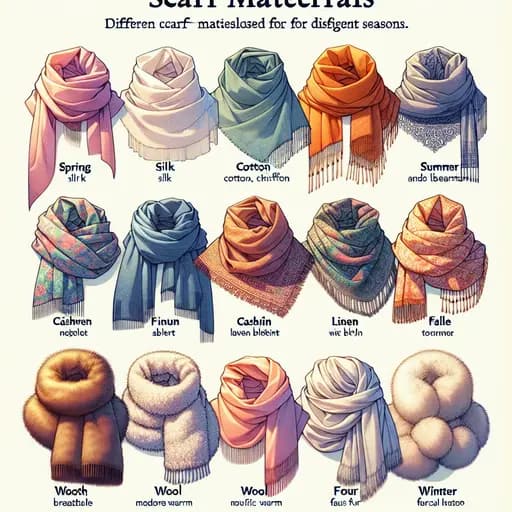
5. Different Scarf Materials for Different Seasons
The right material for your scarf can take a simple accessory from good to great in any season. Each material has unique properties that can either amplify or dampen the effectiveness of your scarf-depending on the time of the year. Some considerations to keep in mind include warmth, texture, weight, and how well the fabric drapes. Read on to discover which scarf materials are best suited for each season.
Spring: Delicate Fabrics
- Silk: Silk scarves are light, soft, and breathable-making them perfect for the gently warming spring weather. Silk has a unique ability to regulate temperature, ensuring you never feel too hot or too cold.
- Cotton: Cotton scarves are versatile and practical, providing a light layer of warmth on fresh spring days while still allowing air circulation.
- Chiffon: If style is your prime concern, the lightweight chiffon is ideal. It is sheer and elegant and adds the perfect finishing touch to any spring outfit.
Summer: Breathable and Light Fabrics
- Linen: Linen scarves excel in the hot summer months due to their breathability and natural cooling effect.
- Voile: A very lightweight, semi-sheer fabric, perfect for adding a bit of style without overheating.
Fall: Medium Warmth Fabrics
- Wool Blend: As temperatures start to dip, a wool blend scarf will effectively retain body warmth without causing discomfort due to overheating.
- Cashmere: Cashmere is renowned for its superior softness and warmth, making it a great choice for the crisp fall weather.
Winter: Warm and Heavier Fabrics
- Wool: Wool scarves are the traditional go-to for winter. They provide excellent insulation and make a warm, cozy addition to any outfit.
- Faux Fur: Faux fur scarves not only offer a stylish aesthetic but also provide considerable warmth and comfort during the harshest winter months.
A scarf’s material not only impacts its function but also plays a crucial role in how it drapes and shapes. By understanding these nuances, you can pick a scarf that is both stylish and seasonally appropriate.
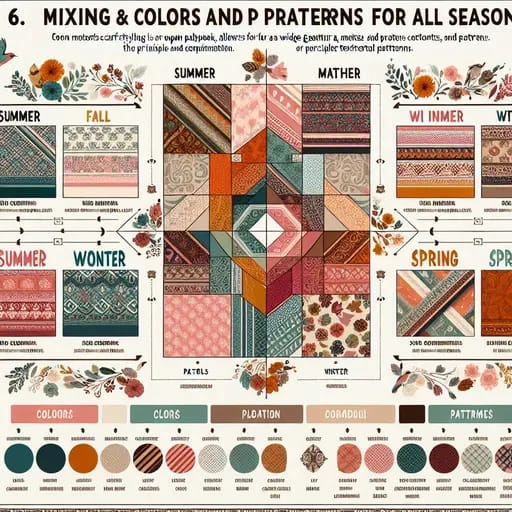
6. Mixing and Matching Colors and Patterns for All Seasons
The beauty of scarves does not reside exclusively in their functionality but in their transformative power to revolutionize an outfit. A correctly chosen scarf can either be a subtle accessory or a outstanding statement piece. To enrich your styling game, diversity in colors and patterns is key. We shall explore just how you can seasonally adapt your scarf’s color selection and pattern choices to enhance your wardrobe.
- Summer: Summer calls for a lighter, brighter color palette. Consider pastels, whites, or vibrant patterns to compliment your summer wardrobe. A floral patterns are excellent for this season, it gives a tuneful vibe for your summer look.
- Fall: As the leaves change, so should your color choices. Earthy tones, such as browns, olives, and oranges, reflect nature’s transformation. Plaids and paisleys come to life in this season.
- Winter: Winter deserves warm and deep colors like burgundy, emerald green, or navy blue. Scarves with complex and textured patterns will add a touch of unique boldness to your winter ensemble.
- Spring: Say hello to spring with a mixture of bright and soft tones like pinks, blues, and yellows. Patterns that include floral motifs, birds, or geometrical shapes are a fresh addition to your spring attire.
Mixing colors and patterns might seem intimidating at first, but the key to mastering it is understanding contrast and coordination. Use the principle of opposites when it comes to colors. For patterns, you can mix them if they share a common color palette.
Scarf styling is ultimately an open playbook, an allows for a wide gamut of experimentation. Have fun with it, let your scarf be an extension of your mood, personality, and style. Remember, confidence is the greatest accessory of all.
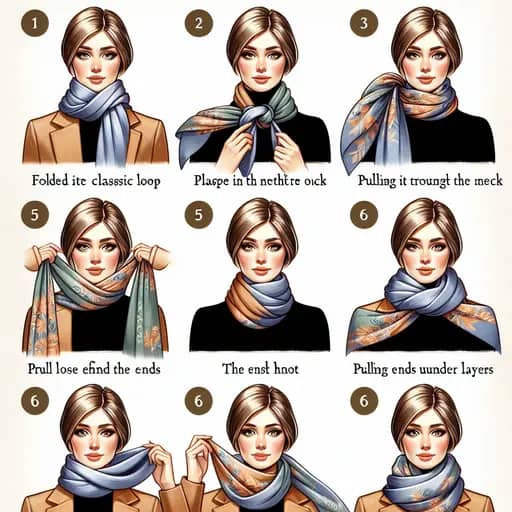
7. Ways to tie a scarf for different looks
One of the greatest advantages of scarves is their versatility. Not only can they provide warmth and style, but they can also transform your look based on how you choose to fold, wrap, and knot them. Here are seven different ways you can tie your scarves to create a variety of looks:
- Classic Loop: Delicate and sophisticated, the Classic Loop is a timeless way to arrange your scarf. Simply fold the scarf in half, drape it around your neck, and then pull the loose ends through the loop.
- The Infinity: A fantastic option for long scarves, The Infinity gives a warm and stylish feel to your look. To achieve this, drape the scarf around your neck twice, knot the ends together and hide them under the scarf layers. It’s as simple as that.
- French Knot: Chic and polished, the French Knot brings a sense of elegance to your outfit. First, fold the scarf in half and place it around your neck. Then, pull one end through the loop. Twist the loop, and pull the other end through. This sophisticated knot is a perfect style enhancer.
- The Turtleneck: Ideal for harsh winter conditions, this method will keep you warm and comfortable without compromising on fashion. Wrap the scarf around your neck multiple times and tuck in the ends for a snug, cozy fit.
- Modern One Loop: A trendy look perfect for transitional seasons like spring and fall. Drape the scarf around your neck, leaving one side longer than the other. Take the longer end, loop it around your neck, and let both ends hang loose in the front. This gives a relaxed, breezy look.
- The X: An innovative way to sport your scarf. Start with a diagonal fold, then wrap the ends around your neck crossing them in the back and bringing them back to the front. This creates a ‘X’ shape at your chest for a fresh, statement look.
- Boho Loop: Creates a laid-back and fashionable look, ideal for casual days. Place the middle of the scarf to the front of your neck and then loop the ends around your neck, bringing them back to the front. The result is a voluminous, chic design.
Each style offers a unique charm and feel, giving you the freedom to express your personal style while also matching your outfit and the season. Learning how to style a scarf can really take your fashion game to the next level, setting you apart with your individual statement.
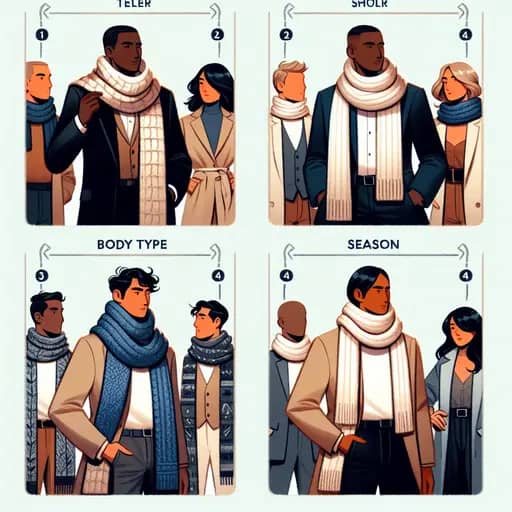
8. How to Choose the Right Scarf Length for Your Outfit
After exploring various styling methods, let’s dive into examining one of the most important aspects of scarves: the length. Choosing the right scarf length ensures a balanced look and adds an extra pinch of finesse to your ensemble. Not only does it complement your outfit, but it also aligns with the season’s demands. Let’s walk through various criteria to pay attention when selecting the scarf length:
- Consider Your Body Type: It is crucial to consider your body shape and height when buying a scarf. Taller individuals may opt for longer scarves as they can create a sense of balance, while those who are short can opt for shorter scarves to avoid feeling enveloped by it.
- Think about your outfit: The type of outfit you wear can influence the most suitable scarf length. Long scarves can be a good fit with coats or simple shirts, creating a statement piece, while short scarves may work better for layered or textured outfits, adding a subtle touch.
- Reflect on the Season: The length of a scarf also depends on the weather. Longer, chunky scarves are perfect for the cold winter months, while shorter, lightweight ones are ideal for a breezy summer or spring look.
- Check the Scarf’s Function: If functionality is top-rated, longer scarves often provide more flexibility and warmth, while shorter scarves are mainly for fashion aesthetics.
Remember, the choice of a scarf length can make or break your outfit, but it also depends greatly on your comfort. The essence of fashion lies in your self-expression. So, experiment, mix and match, and create a style that’s uniquely yours while keeping in mind the suggestions made here.
In our next section, we will provide you with some valuable tips for maintaining the quality of your scarves and ensuring they last for many seasons to come. Stay with us as we continue to explore the vast world of scarves and their transformative style potential.
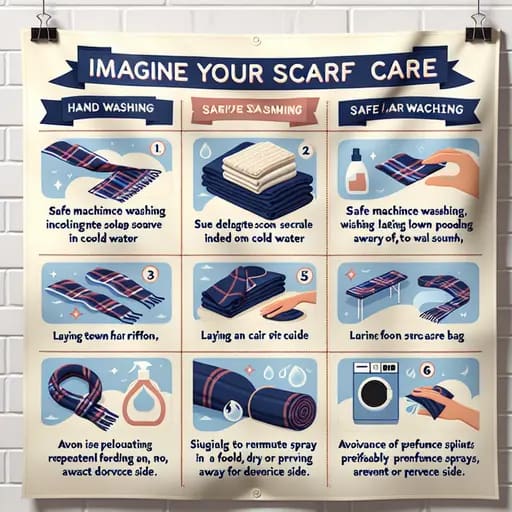
9. Tips for Caring for Your Scarves to Make Them Last Longer
Knowing how to care for your scarves properly can greatly extend their lifespan, ensuring they remain a staple in your wardrobe for many years. Here are some key points on how to keep your scarves looking fresh and new, season after season:
- Hand washing: This is usually the safest method to clean your scarves, especially for delicate materials like silk or wool. Use cold water and a mild detergent, then gently work the soap into the fabric and rinse thoroughly.
- Machine washing: If the tag indicates that machine washing is safe, use the delicate cycle with cold water. We recommend putting your scarf in a mesh laundry bag for extra protection.
- Drying: Instead of wringing your scarves out, which can damage the material, roll them in a towel to absorb excess moisture. Lay them flat to air dry, away from direct sunlight.
- Storing: Avoid folding scarves in the same place repeatedly, as this can lead to creases that are hard to remove. Instead, roll or loosely fold your scarves. Choose a cool, dry place to store them, away from sunlight.
- Ironing: If needed, use the lowest heat setting on your iron and preferably iron on the reverse side of the scarf to prevent any potential surface damage.
- Avoid perfumes: Direct application of cosmetics or perfumes can stain scarves. Apply these products before wearing your scarf to prolong its longevity.
Following these care instructions will ensure that your scarves preserve their charm and versatility for every season. Remember, proper care can extend the life of any garment, and scarves are no different. Make more sustainable fashion choices by maintaining your pieces and wearing them season after season.
Up next, we’ll be discussing how to enhance your style with scarves year-round. Stay with us for the conclusion of our detailed guide!
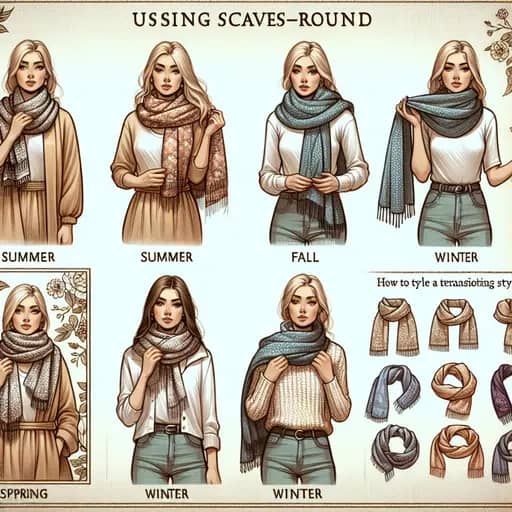
Conclusion: Enhancing Your Style with Scarves Year-Round
Regardless of the season, scarves can bring variety, sophistication, and flair to your look. By understanding the flexibility of scarves and exploiting it to your advantage, you can maintain an ever-changing, stylish wardrobe year-round. In conclusion, here are key takeaways from our comprehensive guide:
- Summer: Lightweight scarves can effortlessly complementing your summer style, while someone providing cover during a chilly summer night.
- Fall: As you begin layering your clothes for the fall, cosy knit scarves can add both warmth and elegance to your autumnal attire.
- Winter: For the cold, freezing winter, nothing works and looks better than a carefully styled scarf, which provides ultimate warmth and comfort.
- Spring: Scarves can seamlessly blend into your transitional spring wardrobe, enhancing your style quotient while providing the necessary protection.
Remember that different materials work best for different seasons, so always consider this when choosing a scarf. Don’t shy away from mixing and matching colors and patterns to keep your look refreshing and vibrant throughout the year. Finally, understand how to appropriately tie your scarf to suit your outfit and the season, and take good care of them to ensure longevity.
In conclusion, with our guide on how to style a scarf for every season, you’re now equipped to enhance your style quotient throughout the year. Remember, a well-styled scarf has the potential to transform an ordinary look into an extraordinary one. So, keep experimenting and wear your scarf with confidence and grace!

